The Trinity-St. Sergius Lavra: Architectural Ensemble,
Pages of History (14th – 18th cc.) (page 1)
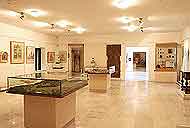 The exhibition is housed in the ground floor of the Southern building of the Historical and Architectural Complex of the 18th – 19th century called “Konny Dvor”. The objects on display reflect the main steps in the development of the Lavra architectural ensemble in the context of the most remarkable historical events. Different periods of the monuments history are illustrated in a series of three-dimensional and graphic reconstructions, displayed in all parts of the exhibition. The majority of exhibits were made by famous architects I.V. Trofimov, V.I. Baldin, A.G. Ustinov, B.D. Komarov, who reconstructed, restored and preserved the monuments of the Trinity-St. Sergius Lavra.
The exhibition is housed in the ground floor of the Southern building of the Historical and Architectural Complex of the 18th – 19th century called “Konny Dvor”. The objects on display reflect the main steps in the development of the Lavra architectural ensemble in the context of the most remarkable historical events. Different periods of the monuments history are illustrated in a series of three-dimensional and graphic reconstructions, displayed in all parts of the exhibition. The majority of exhibits were made by famous architects I.V. Trofimov, V.I. Baldin, A.G. Ustinov, B.D. Komarov, who reconstructed, restored and preserved the monuments of the Trinity-St. Sergius Lavra.
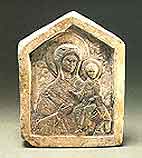 The first hall of the exposition presents the materials illustrating the beginning of the Monastery arrangement against the background of the stormy historical events of the 14th – 15th century. Founded in the 1340s, the Trinity-St. Sergius Monastery played a significant role in the formation of the Moscow State. Venerable Sergius of Radonezh, the Monastery founder and first hegumen, became a brilliant symbol of Russian spirit and patriotism, a moral support for his contemporaries and for subsequent generations.
The first hall of the exposition presents the materials illustrating the beginning of the Monastery arrangement against the background of the stormy historical events of the 14th – 15th century. Founded in the 1340s, the Trinity-St. Sergius Monastery played a significant role in the formation of the Moscow State. Venerable Sergius of Radonezh, the Monastery founder and first hegumen, became a brilliant symbol of Russian spirit and patriotism, a moral support for his contemporaries and for subsequent generations.
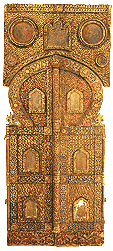 The exhibits of the first hall characterize the Monastery as a major center of Old Russian culture. The central model of the 15th century Monastery helps to perceive the scope and the enchanting beauty of the cloister constructed by outstanding craftsmen. The stone icon depicting the Virgin Hodigitria is a remarkable monument of that time. It was presumably connected with the name of a talented sculptor and architect Vassili Ermolin.
The exhibits of the first hall characterize the Monastery as a major center of Old Russian culture. The central model of the 15th century Monastery helps to perceive the scope and the enchanting beauty of the cloister constructed by outstanding craftsmen. The stone icon depicting the Virgin Hodigitria is a remarkable monument of that time. It was presumably connected with the name of a talented sculptor and architect Vassili Ermolin.
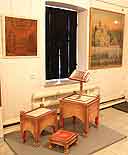 The exposition presents materials on history of book writing: manuscripts, ancient books, icons, writing utensils and a reconstruction of “a scribe’s corner”. At the beginning of the 15th century, a famous Old Russian writer Epiphanius the Wise worked in the Monastery. He wrote “The Life of St Sergius”.
The exposition presents materials on history of book writing: manuscripts, ancient books, icons, writing utensils and a reconstruction of “a scribe’s corner”. At the beginning of the 15th century, a famous Old Russian writer Epiphanius the Wise worked in the Monastery. He wrote “The Life of St Sergius”.
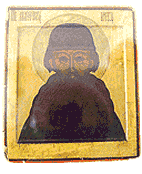 As time went on, the large library was formed with participation of the local monks. One of them was Maxim the Greek, a talented writer and publicist of the 16th century. A disgraced philosopher, exiled to the Monastery Maxim the Greek stayed there till the end of his life. He was buried in the Monastery. The exhibition includes the icon with his image k though he was officially canonized long after.
As time went on, the large library was formed with participation of the local monks. One of them was Maxim the Greek, a talented writer and publicist of the 16th century. A disgraced philosopher, exiled to the Monastery Maxim the Greek stayed there till the end of his life. He was buried in the Monastery. The exhibition includes the icon with his image k though he was officially canonized long after.
|


